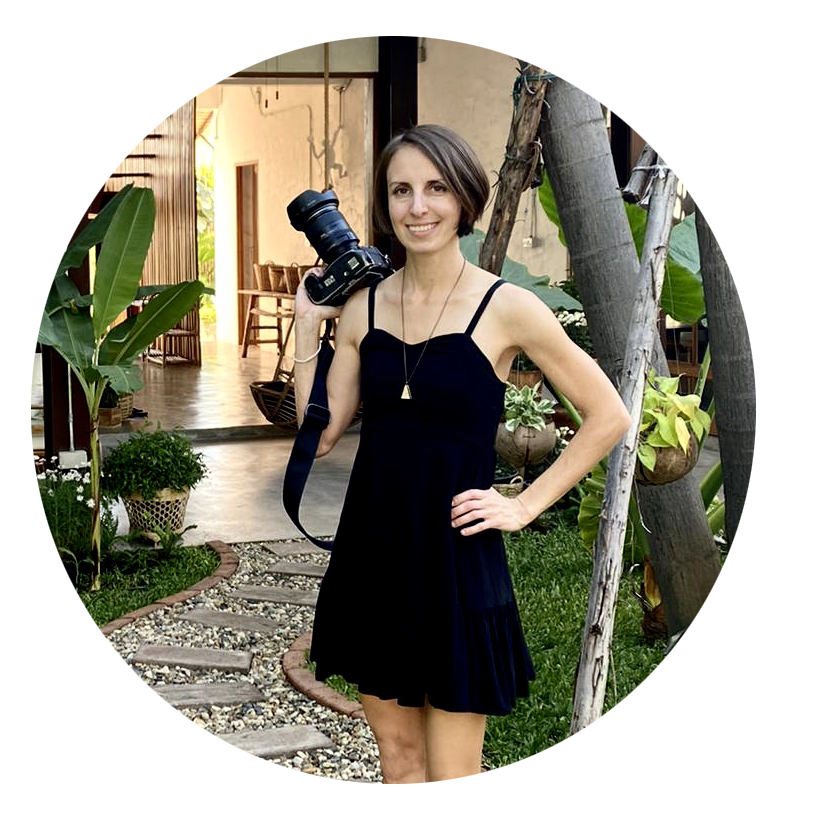 The view of Plaza del Congresso and the Argentine parliament building from Palacio Barolo, one of the city’s most beautiful buildings.
The view of Plaza del Congresso and the Argentine parliament building from Palacio Barolo, one of the city’s most beautiful buildings.
There is no city in the world as seductive as Buenos Aires. While the skyline isn’t sexy, the city itself is intoxicating. The streets are lined with grand European palaces, cozy cafes and endless parks. The stables of life are steak, wine and ice cream. Dinner never starts before 9 p.m. and most places close daily for an afternoon siesta. After dinner, everyone dances tango until almost sunrise.
I fell in love with this city on my first visit in 2015 and have been back many times to live during the U.S. winter. I even wrote about my love affair with Buenos Aires for a travel story for the Washington Post, which digs into the history and beauty of the city. In addition to that story, I made a more detailed guide of the best places to visit, eat and tango in Buenos Aires.
From eSIM cards to travel medical insurance, keep reading for all the details about where to go in Buenos Aires and how to best prepare for your trip!
Affiliate links are used in this post. If you make a purchase, I earn a small commission at no cost to you, which goes toward the cost of maintaining this blog.
Plan Your Trip
Currency: Argentinian Peso (ARS)
When to Go: Spring (September to November) & Spring (March to May)
Travel Insurance: Protect yourself with SafetyWing travel medical insurance to cover accidents and travel delays.
Mobile eSIM Card: Get seamless connectivity worldwide with Airalo minus the hassle of physical SIM card. (Save 10% with code AIRALOESIM10!)
When to Go To Buenos Aires
Peak season for tourism is their summer—December to February, which is when I prefer to go because I love the heat. Temperatures range in the 80s most of time, but start to cool off to high 70s in February. The shoulder season of November and March are also nice. November is when the famous jacaranda tree purple flowers bloom, but weather will be chilly enough where you’ll still need a light jacket.
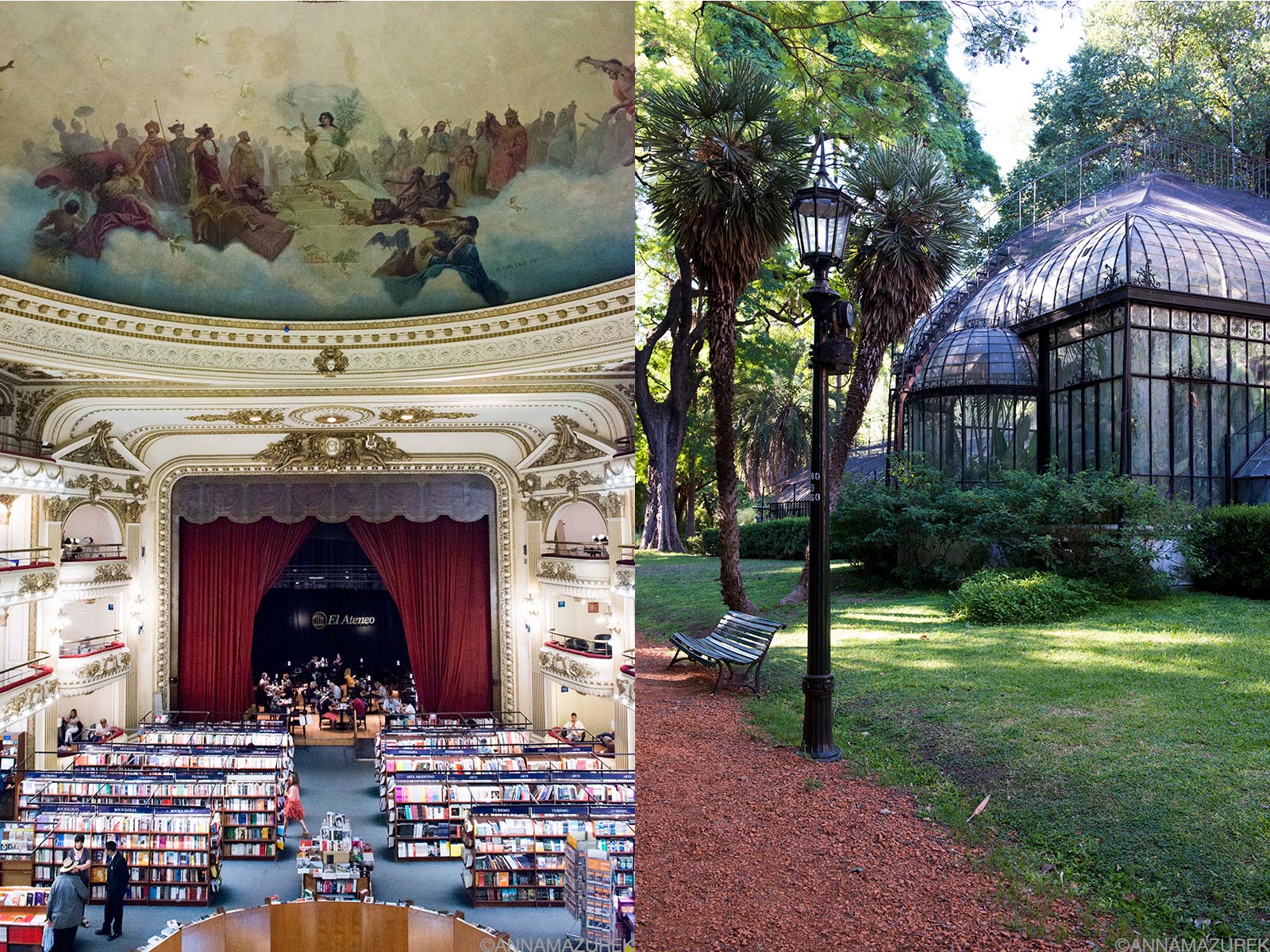 El Ateneo Grand Splendid bookstore (left) and Buenos Aires Botanical Gardens (right) are both gorgeous and free!
El Ateneo Grand Splendid bookstore (left) and Buenos Aires Botanical Gardens (right) are both gorgeous and free!
The Best Things to Do in Buenos Aires
-
Palacio Barolo is the best spot for a scenic view of the skyline and the parliament building. The building was inspired by Dante’s Divine Comedy and has 22 floors that match the content of the poem directly. The palace now consists of many offices, but they have daily tours that take you into the lighthouse at the top of the building.
-
Le Recoleta Cemetery. One of the most notable graves in La Recoleta Cemetery belongs to Eva Perón. The 14-acre grounds are hauntingly beautiful – elaborate above-ground marble mausoleums and statues cover a sprawling grid of four city blocks lined with large walkways. Be sure to check out the weekend market in the adjacent park. Free Entry.
-
Attend a Boca Juniors or River Plate football game for one of the cites most exciting experiences Tickets for games must be booked through travel agents, GetYourGuide or Viator. If you can’t attend a game, a stadium and museum tour is your best option for both River Plate and La Boca. Read reviews before booking. (Keep an eye on your belongings in the La Boca area and avoid it at night.)
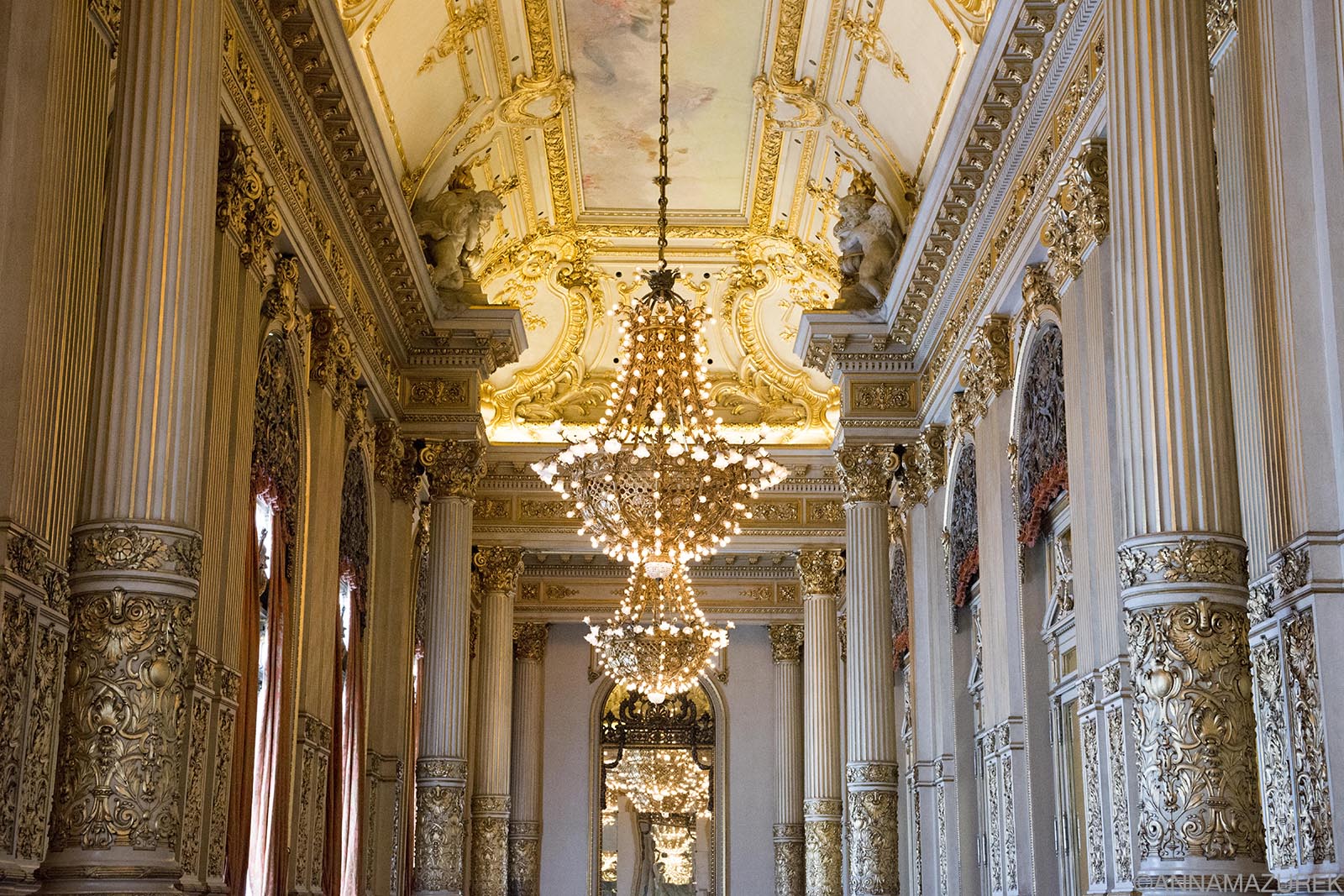 The stunning chandeliers in Teatro Colon in Buenos Aires.
The stunning chandeliers in Teatro Colon in Buenos Aires.
-
Teatro Colón is not only one of the finest opera houses in the world but one of the most beautiful buildings in the city. Built in 1908, the seven-story theater covers an entire city block and features ballet, opera and concert performances. Many of the lavish building materials – Venetian mosaics, French stained glass and three kinds of Italian marble—were all imported from Europe. If you can’t catch a performance, take one of the hourly guided tours. Tours run every 15 minutes from 9 a.m. to 5 p.m. daily in both English and Spanish.
-
El Ateneo Grand Splendid Bookstore has a story just as interesting as the décor. The building opened in 1919 as a theater called the Teatro Gran Splendid before converting into a cinema, which showed the first sound films in the country. The theater-turned-cinema was then converted into a bookstore in the early 2000s. Much of the interior, including the ornate carvings, remain intact. Bookshelves replaced the rows of seats, and the theater boxes were left for customers to curl up with a book. Dark red curtains frame the stage, which is now home to a quaint café. Free entry.
- National Museum of Decorative Arts is housed in a 1917 beaux-arts mansion that was originally the home of Chilean aristocrat Matías Errázuriz and his wife, Josefina de Alvear. When Alvear died in 1935, the family donated the house and its extensive collection of European and Asian art to the Argentine government under the condition it be used as a museum. The elaborate décor features a ballroom with hand-carved ceilings and artwork by Manet and Rodin. It is the only French mansion built at the beginning of the 20th century open to the public in Buenos Aires. There are also rotating art exhibits in the main floor and basement galleries. Entry is free.
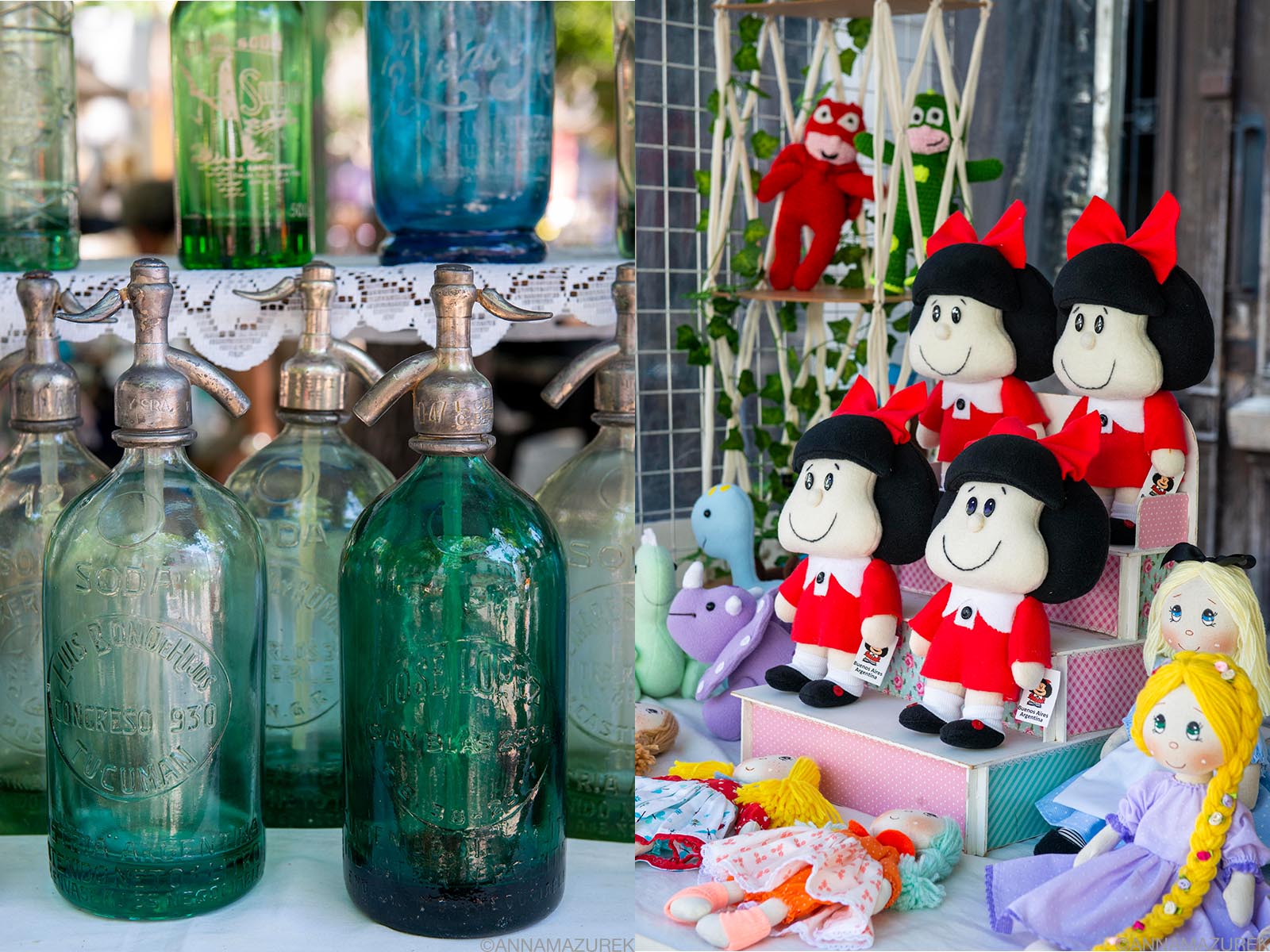 The San Telmo Sunday Market is filled with glass seltzer bottles and souvenirs of Mafalda, a famous Argentine comic strip.
The San Telmo Sunday Market is filled with glass seltzer bottles and souvenirs of Mafalda, a famous Argentine comic strip.
-
San Telmo Street Fair is the place to be on Sunday. Plaza Dorrego, the heart of the market, is focused more on antiques including a row of vendors selling vintage glass seltzer bottles. The stalls stretch out into the adjacent streets and eventually, it turns into more of a flea market with vendors selling leather belts, fresh-squeezed juice and merchandise centered around Mafalda, a famous Argentinean cartoon character. Sundays 10 a.m. – 5 p.m.; Free entry.
-
Parque Tres de Febrero is the biggest public park in the city. It includes a giant lake and a rose garden surrounded by a pedestrian track filled with runners and rollerbladers. It’s my favorite place to run in the city. On weekends, there are stalls renting bikes, pedal carts and skates. The park used to be the private grounds of a dictator and was named after the date he fell from power. Rose garden is open 8 a.m. – 8 p.m. daily.
-
Galileo Galilei planetarium has a nightly light show that you can’t miss. The planet-shaped building changes colors while the fountains in the adjacent lake perform a mini-show on the hour mark. While the museum is open during the day, there is free telescope viewing on weekend nights until 10 p.m. Av. Sarmiento, Light show is free.
- Museo Nacional de Bellas Artes is an art museum with a stunning collection of European master’s including Degas, Monet and Rodin, along with Argentinean artists. Entry is free
- A street art walking tour is a great way to explore Buenos Aires endless neighborhoods from La Boca to Palermo Hollywood. Graffitimundo offers tours, but you must email to book in advance. For shorter notice, book a tour from GetYourGuide or Viator.
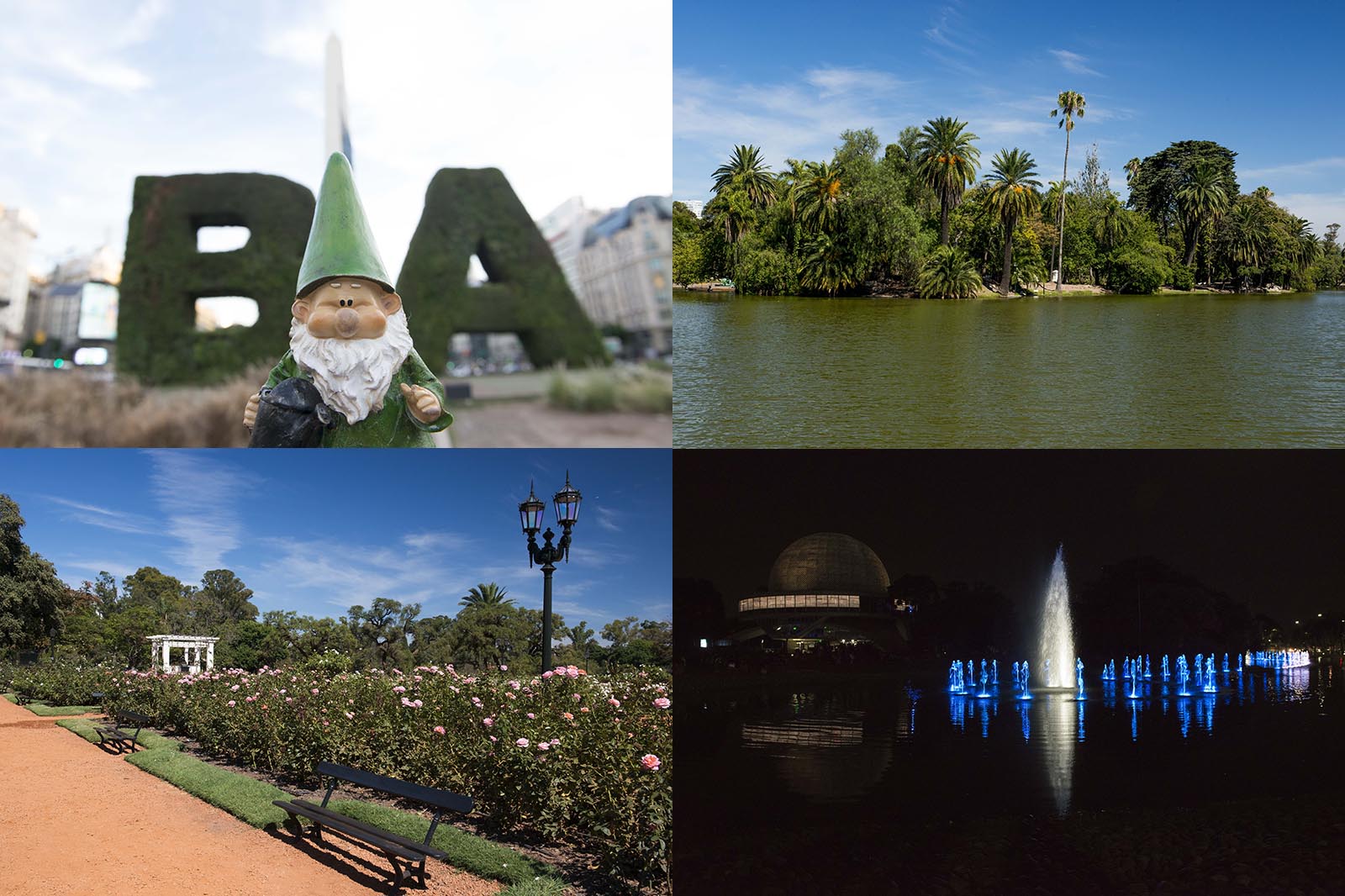 Clockwise from top left: Obelisco de Buenos Aires, Bosque de Palermo, Galileo Galilei planetarium at night and Paseo del Rosedal in Palermo.
Clockwise from top left: Obelisco de Buenos Aires, Bosque de Palermo, Galileo Galilei planetarium at night and Paseo del Rosedal in Palermo.
-
Museo de Arte Latino Americano (MALBA) focuses on Latin American art from the early 20th Century to the present. Highlights include Diego Rivera, Fernando Botero and Frida Kahlo. Be sure to visit on a Wednesday when admission is discounted and free for student and teachers. I got in free with my teacher’s ID from Texas.
-
Obelisco de Buenos Aires is one of the icons of the Buenos Aires. The monument was built in 1936 in honor of the 400th anniversary of the city’s founding. Located at the foot of the monument in Plaza de la República is the giant BA sign that’s Instagram-worthy!
-
Floralis Generica is a metal flower sculpture by Argentine architect Eduardo Catalano in Plaza de las Naciones Unidas. It also has purple lights that appear at night. It’s a fun picnic spot. FIGUEROA ALCORTA, PRES. AV. 2301, Free entry.
-
Jardín Botánico Carlos Thays (botanical gardens) is a peaceful escape from the city. Built by French landscape architect Carlos Thays, the green space includes over 1,500 plant species, Roman-style statues and a glass-domed greenhouse. Thays is also responsible for creating, remodeling and expanding 69 public spaces in the city.
-
Buenos Aires Ecological Reserve is the largest green space in the city. It’s a great place to rent a bike and explore. The 865-acre reserve lies east of Puerto Medaro on the bank of the Rio de la Plata. It’s packed with locals on weekends and a market by the south entrance. Free entry.
-
The Buenos Aires Metropolitan Cathedral is the main Catholic Church in the city center. Pope Francis used to perform mass here until he became Pope in 2013. It also houses a Pope Francis Museum. Entry to the cathedral is free.
-
Stroll La Caminito, a colorful pedestrian street in the La Boca neighborhood surrounded with houses built of brightly painted wood and sheet metal. Explore the museums and shops during the day. Petty theft is an issue in La Boca, and it’s dangerous at night.
- Free Walking Tour. There are several companies that offer free walking tours, and the guides work for tips only. This is a great way to get an idea of the city to start your trip.
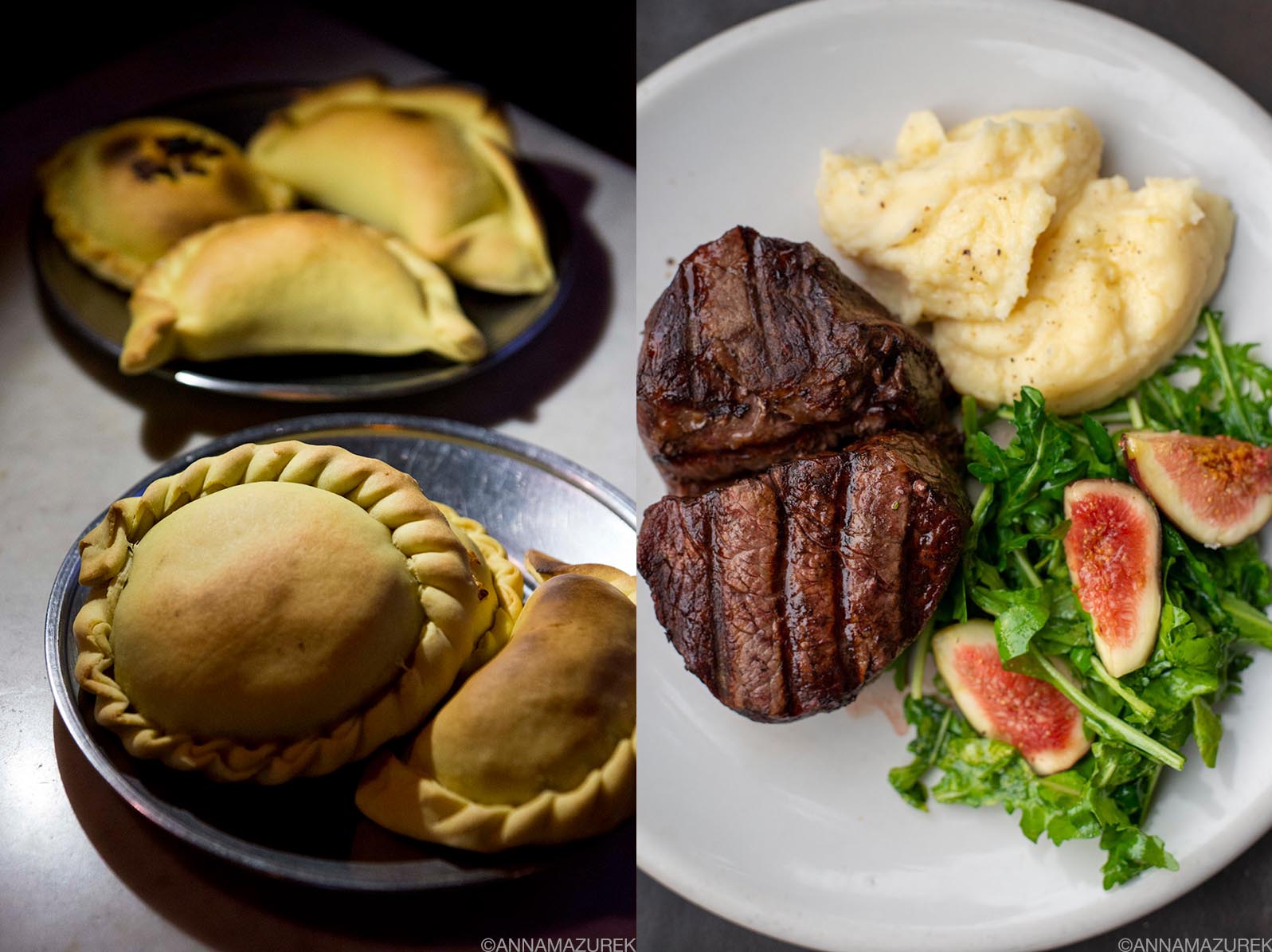 Left: Empanadas from La Cocina are the best in the city! Right: Steak from Don Julio, which was voted the best restaurant in Latin America in 2020 and 2024.
Left: Empanadas from La Cocina are the best in the city! Right: Steak from Don Julio, which was voted the best restaurant in Latin America in 2020 and 2024.
The Best Places to Eat in Buenos Aires
- Don Julio was voted the best restaurant in Latin America in 2024. The traditional Argentine steakhouse is the best steak in town. Reservations recommended.
- El Preferido de Palermo is a great dinner spot owned by the team behind Don Julio. Their milanesas (breaded meat cutlets) are delicious. Reservations recommended.
- La Cabrera is a Palermo parrilla (steakhouse) with a nightly happy hour from 6:30 to 8 p.m. Everything (steak, salad and even wine) is 40% off. The only catch is that you must be out before 8 p.m. when they start seating parties with reservations. Juicy steaks are served with an array of small sides ranging from pickles to purees.
- Casa Cavia is a lovely restaurant located in an old mansion with a leafy courtyard patio. It’s been my go-to brunch spot, but it’s also open for dinner. The homemade scones with dulce de leche are fantastic.
- Pain et Vin is my favorite wine shop/bar in Palermo. They serve light cheese plates but not proper meals.
- Usina and GOIN! are two Recoleta cafes I like for breakfast, lunch and an early dinner. (They close around 8 or 9 p.m., which is early for Argentine standards.)
- La Cocina has the best empanadas in town! This tiny hole in the wall has only 14 seats and plays classic rock music. I recommend the carne picante (beef), the pikachu (onion, cheese and red pepper flakes) and choclo (corn).
- L’Orangerie is located in the swanky Alvear Palace Hotel in Recoleta. This restaurant serves afternoon tea featuring a selection of miniature sandwiches, pastries and scones.
 Left: Alfajores (dulce de leche with cornmeal cookies are available across the city); Right: Strawberry cheesecake from L’Orangerie at the Alvear Palace Hotel.
Left: Alfajores (dulce de leche with cornmeal cookies are available across the city); Right: Strawberry cheesecake from L’Orangerie at the Alvear Palace Hotel.
-
La Fachada has the best selection of empanada flavors in town including pumpkin (my favorite), pineapple (my second favorite) and Caprese. Their pizza also looks delicious. They have two locations so check their website for details and times.
-
Narda Comedor is a healthy eatery run by famous Argentine chef Narda Lepes, who was trained in France. There’s a nice patio and they spread the tables out into the park across the road during the daytime. Their mains are large portions and the panna cotta is delicious.
-
Croque Madame Café has a delicious array of cakes and quiches. There are multiple locations but the most scenic is the garden location at the Museum of Decorative Arts.
-
Lucciano’s is a family-owned ice cream chain that’s one of my favorite ice cream spots. The pomelo is my favorite flavor.
- For San Telmo, El Blanco Rojo, Bar Chin-Chin and Virrey Cocina Urbana were my go-to spots in 2018. They are still around, but I didn’t spend much time in San Telmo this trip.
The Best Craft Beer in Buenos Aires
Craft beer is slowly infiltrating the city. Many breweries have daily happy hours.
-
Buller Brewing is a brewery with an amazing rooftop patio overlooking Recoleta cemetery. Their beer, burgers and onion rings are fantastic.
-
Rabieta is probably my favorite microbrewery with nine of their own beers and other local brews on tap. You can’t beat the location on the horse racing track. Their patio is expansive, and they also serve bar food.
-
1516 Cerveceria in Palermo has a giant patio. On Tap serves 20 beers from local microbreweries and has several locations.
- Jugetes Perdidos never makes the same beer twice. You can find their beer in bars in town, but they don’t have a taproom. The brewery offers tours in their taproom every Saturday. Make reservations by calling or via Facebook Messenger. Tours are in Spanish, but they speak English if you have questions. Tour is free, but you pay for a beer and a complimentary glass. Bolivia 3342.
The Best Coffee in Buenos Aires
Since I don’t drink caffeine, I’m passing along recommendations from my coffee-loving friends. Santa Café is run by a Colombian couple so you know the coffee is good. It’s across from the Intercontinental Hotel. Everyone raves about their flat white. LAB is a great coffee spot with bar-style seating in Palermo that also has bagels. Coffee Town is a popular spot in San Telmo.
Where to Dance Tango in Buenos Aires
Taking at least one tango lesson is a requirement for any visit to Argentina. Aside from lessons, attend a milonga, a term that describes a type of music but is a common reference for a tango show. Many milongas have professional dancers perform throughout the night but have the dance floor open to the public otherwise. Here are a few regular spots that are still open:
- On Sunday nights, there’s usually outdoor tango at La Gloretia, a gazebo in Barrancas de Belgrano park.
- La Cathedral is the dive-bar equivalent of a milonga with the dance floor surrounded by mix-matched chairs that look like they came from a consignment shop. They offer lessons during the day have a milonga every night. It’s a great spot to go out on weekends and has a great vibe. The professional dancers are always amazing. They traditionally have two-for-one entry before 10 p.m. every night deal.
- Other options include La Viruta and Salon Canning, which is a more traditional venue with more of a dress code than other venues.
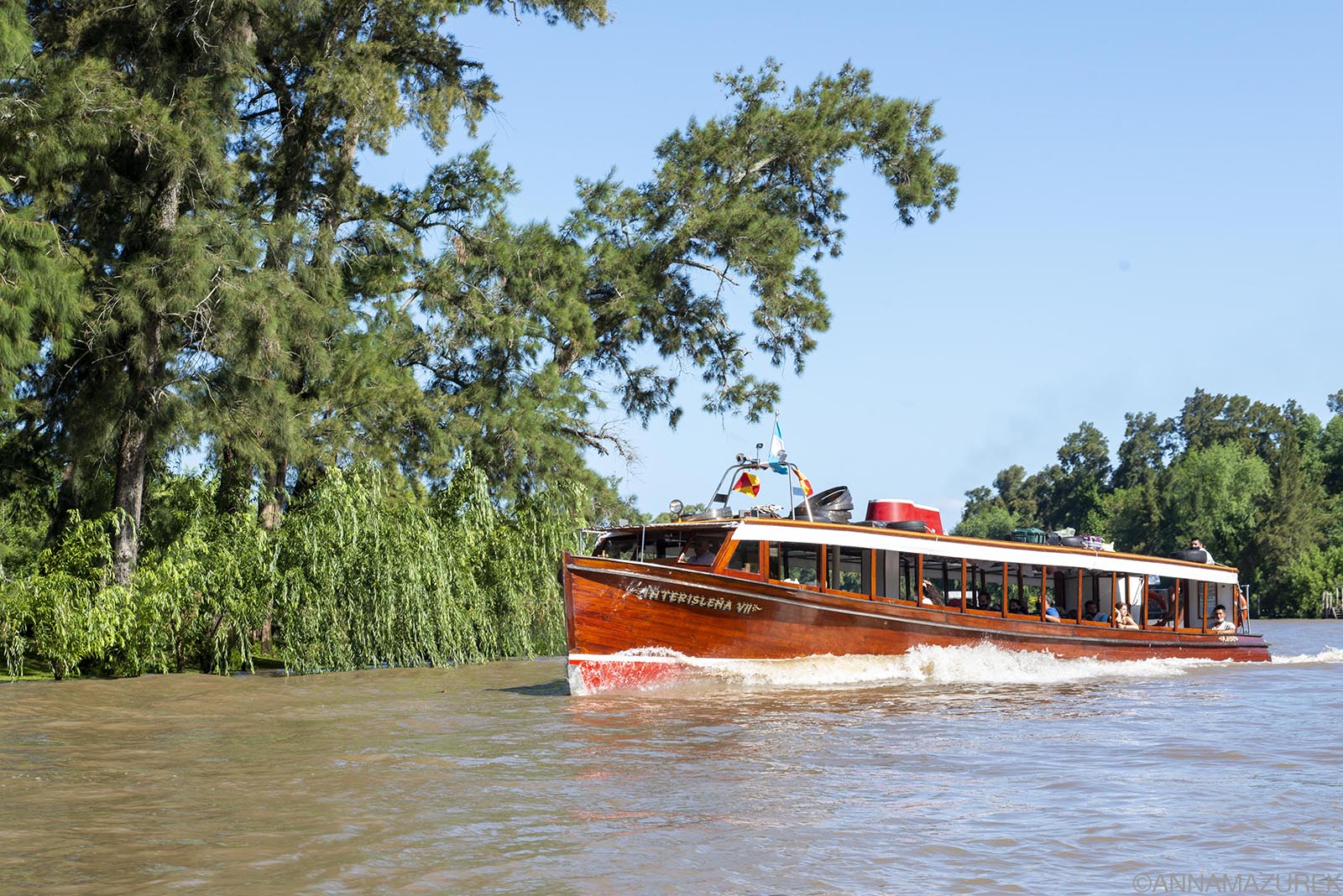 The waterways of Tigré, the gateway to the Paraná Delta located 18 miles north of the city, are a great day or weekend trip. Be sure to take a one-hour boat tour through the canals and residential parts of the delta.
The waterways of Tigré, the gateway to the Paraná Delta located 18 miles north of the city, are a great day or weekend trip. Be sure to take a one-hour boat tour through the canals and residential parts of the delta.
Day Trips from Buenos Aires
If you are looking to escape the city, there are several great day trips. You can do these on your own or book a group tour through GetYourGuide or Viator.
- Tigre is a series of scenic canals lined with vacation cottages that’s popular with locals. It is also known for its museums: Museo de Mate (famous loose leaf tea) and Museo de Arte de Tigre, an art museum dedicated to Argentine artists housed in a 1912 social club. It’s easily accessible by train from Retiro station. I recommend the more scenic Tren de la Costa and stopping at other stations along the way to explore the coast. It’s also easy to book day tours that take you by van and include the cost of the boat tour.
- La Plata is South America’s first completely planned city built on an elaborate grid famous for the towering neo-Gothic Cathedral and a natural history museum that’s touted as Argentina’s best museum. There is a direct train from Constitución station.
- San Antonio de Areco is a picturesque small town in the Pampas (lowlands area) known for gaucho (local skilled horseman) traditions.
- Colonia del Sacramento: Take the one-hour ferry to Uruguay to visit this peaceful postcard-perfect colonial town in Uruguay. Check out my guide to Colonia, here. (Uruguay is so amazing that you’ll fall in love instantly and want to stay for more than a weekend.) You can easily buy ferry tickets online.
Public Transport in Buenos Aires
-
Public transport. Buenos Aires has an extensive network of subway trains (Subte) and buses (Sube) that are both efficient and budget-friendly. You need a reusable Subte card, which you can buy at the stations.
-
Eco Bici The city offers a system of rental bikes around the city, which you can check out for an hour at a time. Tourists can sign up for the program and upload a copy of their passport and entry stamp.
- Ubers & Taxi. Uber exists in Buenos Aires, but it’s much slower than just grabbing a taxi off the street. Be sure to set your payment method to cash if taking an Uber. I find the regular taxis to be cheaper. I normally only use Uber when I don’t know how to explain in Spanish where I want to go. I normally give taxis cross streets to drop me off.
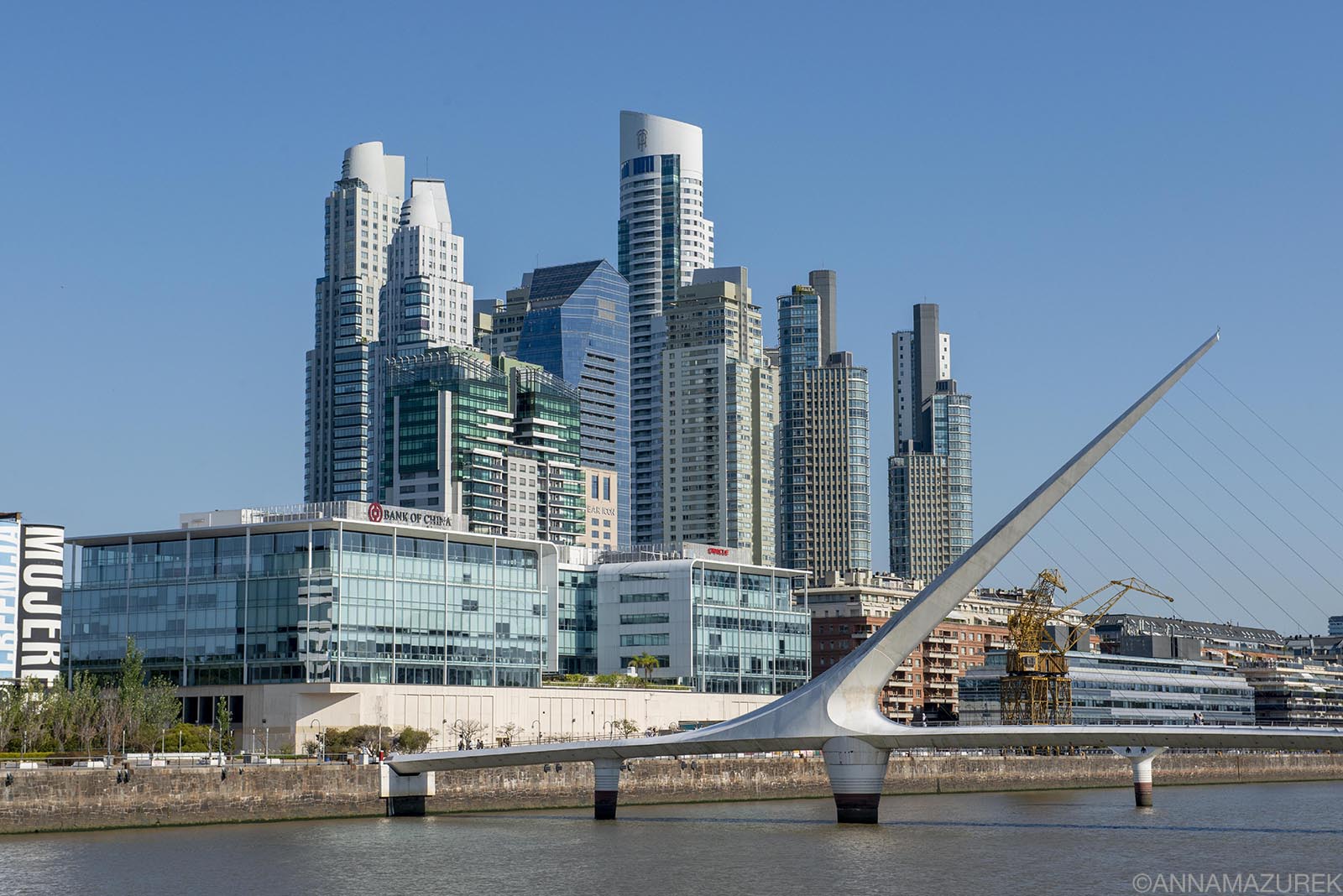 The sleek skyscrapers of the city’s revitalized portside at Puerto Madero. The white bridge is El Puente de la Mujer (Women’s Bridge) is by Valencian architect Santiago Calatrava and it is one of the most famous landmarks in the area.
The sleek skyscrapers of the city’s revitalized portside at Puerto Madero. The white bridge is El Puente de la Mujer (Women’s Bridge) is by Valencian architect Santiago Calatrava and it is one of the most famous landmarks in the area.
Exchange Rates in Argentina: Is Buenos Aires a cheap place to travel?
Inflation has plagued the country for decades and is one of the highest in the world. In December 2023, it peaked at 25% but slowed to around 3.9% in August 2024. Annual inflation remains over 200 percent according to the Associated Press.
In the past, traveling with stacks of U.S. dollars to exchange was the only way to travel in Argentina. The country has long had a two-rate system—an official bank rate and an unofficial rate, known as the blue dollar. Over the years, the rates have fluctuated to being close to even to being drastically different. When the gap between the rates closes, it gets more expensive for anyone traveling with dollars.
As of November 2024, the official rate for U.S. dollars was 973 and the unofficial rate, known as blue dollar, was 1,140. (To give you an example of the inflation rates: In February 2022, it was 106 for the official rate and 209 for the blue dollar, which meant everything was half price for anyone traveling on dollars. When I was there in 2018, both the bank and blue dollar rate were almost even so I just used ATMs for cash.)
Can you use credit cards in Argentina and Buenos Aires?
Yes, travelers can now use credit cards in Argentina and get a “tourist dollar” rate that’s higher than the official bank rate. In December 2022, the country implemented a “foreign tourist dollar” program to give the MEP rate, (Mercado Electrónico de Pagos, which is the rate for investors buying in pesos and selling dollars) to travelers using credit cards (Mastercard and Visa only. ) This means you don’t have to travel around with giant stacks of cash like a drug dealer. Plus, this makes it easier to earn credit parts toward airline status. The MEP rate is not the same as the blue dollar rate but is higher than the official rate. (This website shows both rates, and The Buenos Aires Herald has a great story breaking down the different Argentinean dollar exchange rates.)
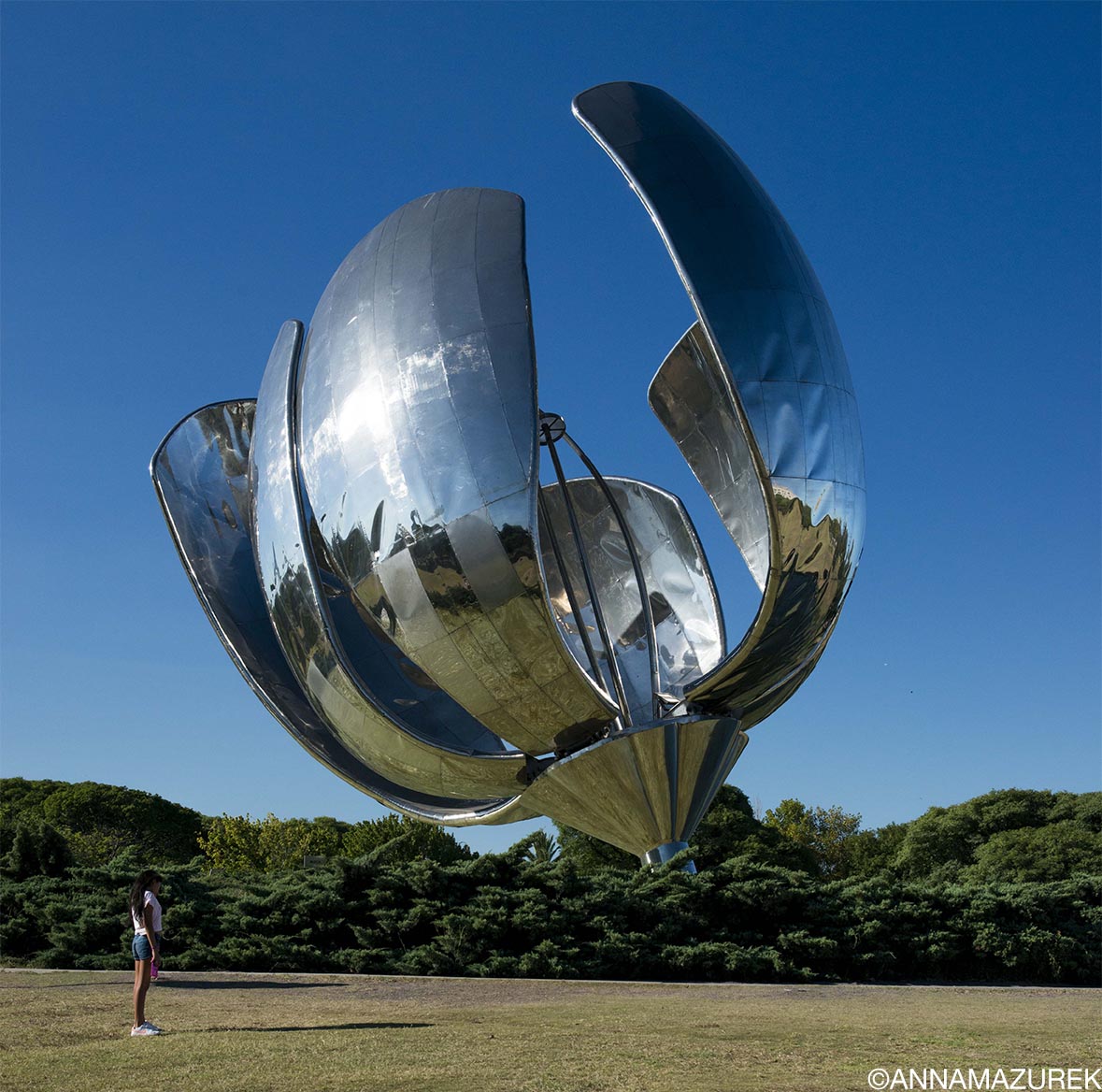 Floralis Genérica is an 18-ton alumiunum sculpture by Eduardo Catalano located in Plaza de las Naciones Unidas.
Floralis Genérica is an 18-ton alumiunum sculpture by Eduardo Catalano located in Plaza de las Naciones Unidas.
Where can you exchange money on the blue dollar rate in Buenos Aires?
If you are bringing U.S. dollars to exchange, make sure you have pristine (no marks or tears) $100 bills. In the past, I’ve used Enviarg Money Transfer, which has a location in Palermo Soho and two in Recoleta. I’ve never had to show a passport or ID to exchange money. I’ve only exchanged a max of $500 at one time. Since rates and regulations are constantly changing, be sure to ask the rate before any transaction.
Otherwise, there’s always Western Union. It’s best to send yourself money through their app (there are fees) because not every location exchanges cash. (This is a great option if you aren’t traveling with a ton of cash.)
Also, it can be tricky to find a Western Union branch that has the amount of money you need so you might be walking around for a while trying different branches. If you go this route, consider doing no more than $200.
While I’ve heard that counterfeits were an issue in the past, I’ve not had any issues. The only people who really look at the bills are store clerks.
Is it cheap to travel in Argentina now?
Argentina is still an affordable place to travel—especially if you are traveling on U.S. dollars—but more expensive than in previous years. This is due to inflation, austerity measures and the removal of public transport subsidies. The locals are the ones hurting the most with the high cost of living. (In early 2022, everything was half price because the blue dollar was so high. Long gone are the days of $37 steak dinners at the famous Don Julio!)
To make the most of your money, check rates before your trip to decide what’s best for you. It can’t hurt to have dollars with you.
Consider using cash to negotiate rates when you can. I’ve always paid cash for my apartments in Buenos Aires, which has enabled me to negotiate rates. The last time, I was able to get the price cut down by almost 30% from $1,400 USD to $950 USD for a spot in Recoleta!
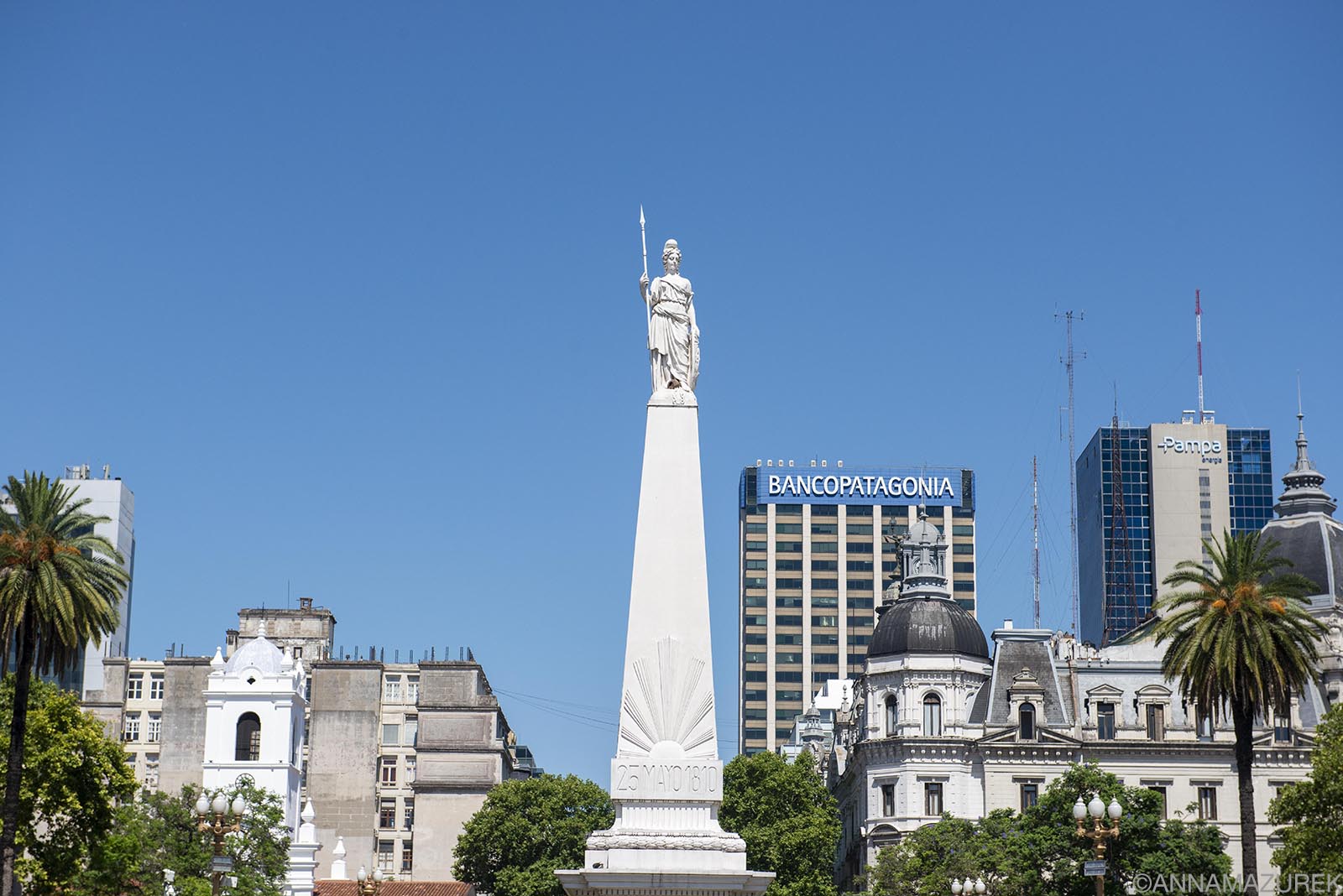 The white obelisk, Pirámide de Mayo, located in Plaza De Mayo, Buenos Aires’ oldest public square, was built to mark the first anniversary from Spain.[/caption]The white obelisk, Pirámide de Mayo, located in Plaza De Mayo, Buenos Aires’ oldest public square, was built to mark the first anniversary from Spain.
The white obelisk, Pirámide de Mayo, located in Plaza De Mayo, Buenos Aires’ oldest public square, was built to mark the first anniversary from Spain.[/caption]The white obelisk, Pirámide de Mayo, located in Plaza De Mayo, Buenos Aires’ oldest public square, was built to mark the first anniversary from Spain.
Is Buenos Aires Safe?
While the inflation is great for those with U.S. dollars, it’s a struggle for those without access. There are more homeless people and people trying to sell you socks and other random things while you are at dinner than there were on my previous trips. (To put it into perspective, the homeless situation in Austin, Texas is tremendously worse than what I’ve seen here lately.)
Petty theft is an issue in Buenos Aires. Watch your bags at all times. I always leave my purse strapped across my body at restaurants. I never put down bags either. (A friend of a friend had their backpack with their laptop swiped from a pub last week.) I don’t feel comfortable working at an outdoor café with my laptop. In 2015, someone tried to pick-pocket my phone out of my purse on the train, but I caught him and got my phone back. (I cornered him on the train and yelled at him until he dropped my phone. Otherwise, I would have jumped on him like a spider monkey.) I would avoid wearing fancy jewelry and Apple Watches.
I keep my passport and money locked in a safe in my apartment. I only take out the money that I need for the day. I also just work from my apartment, so I’m not taking my laptop out in public. When I have my camera, I keep it in my backpack most of the time and never walk around with it strung across my body. The La Boca area is one of the more dangerous ones for petty theft so be careful there. Also, be careful in San Telmo at night and Palermo really late at night.
Do you need travel medical insurance for Buenos Aires?
Yes, travel medical insurance is one of the most important things to purchase for any trip abroad, especially Thailand. It covers all the things that could go wrong from injuries to travel delays so that you don’t have to worry and can focus on traveling!
I use SafetyWing’s Nomad Insurance, which offers $0 deductible travel medical insurance coverage for over 180 countries for people aged 69 and under when traveling outside their home country. The best part is that it only costs a few dollars a day! If you get sick or injured abroad, you can visit any hospital or doctor.
Other benefits of Nomad Insurance include coverage for lost checked luggage, travel delays over 12 hours, motor accidents (if properly licensed, wearing all safety equipment and not intoxicated) and injuries from sports or leisure activities. You can even add adventure sports, electronics theft and U.S. coverage (for non-residents) to your policy.
If you’re abroad for 90 days, you can get 30 days of home-country coverage. (For the U.S. residents, it’s 15 days.) For more details about my experience using SafetyWing in Southeast Asia, read my SafetyWing Review.
Where’s the best place to buy a SIM card in Buenos Aires?
Buying a local SIM card in Argentina is tedious and time consuming because you have to buy it at a phone shop then add credit at a specific type of convenience store, which is hard to find. The easiest thing to do is buy an Argentina specific eSIM card from Airalo that will work instantly when you arrive. To save money, use these promo codes: New customers save 15% off with NEWTOAIRALO15 and existing users save 10% with AIRALOESIM10.
If you are traveling to multiple countries in South America on a short trip, then consider one of their Latin America Regional eSIM cards. Keep in mind it’s always cheaper to buy a country specific eSIM than a regional one.
Be sure to join the free Airalo Loyalty Program to earn 5% cash back for every purchase, which can be redeemed on future purchases! For more about eSIM cards, check out this post on the pros and cons of eSIMs!

